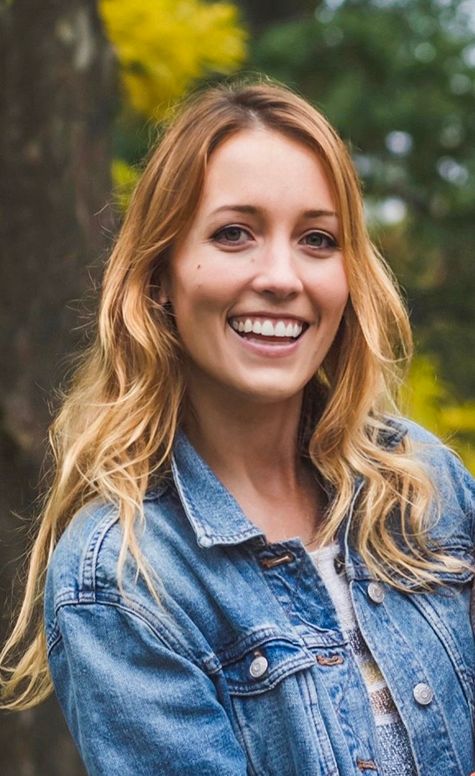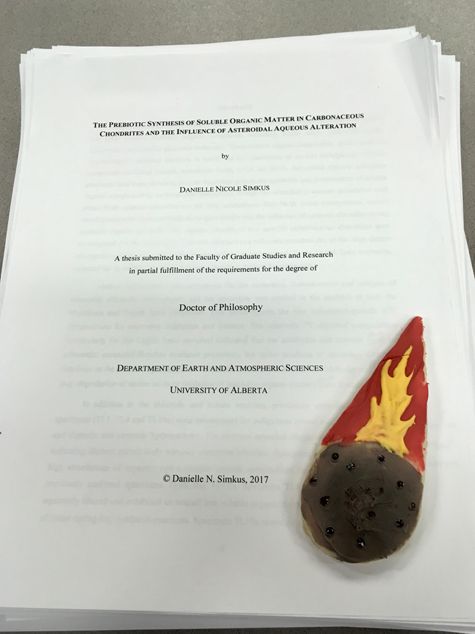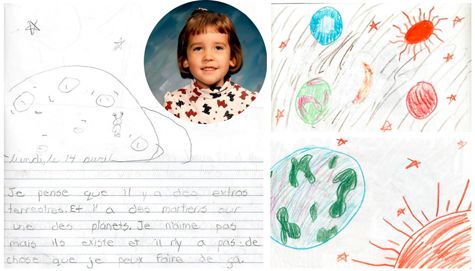Early Career Scientist Spotlight
Dr. Danielle Simkus (she/her)
Astrobiologist
Astrochemistry Laboratory (691)
What is your research focus?
I work in the Astrobiology Analytical Laboratory, and I study the chemistry of space rocks! I analyze meteorites and other extraterrestrial samples to look for small organic molecules that are essential for biology (e.g., amino acids, carboxylic acids, aldehydes, ketones, and alcohols). These molecules, known as “prebiotic organic compounds”, are some the chemical building blocks of life. We think they play an important role in the emergence of life, but we also know that they can be formed through non-biological chemical reactions in space. What this means is that through my experiments I’m not only detecting molecules that formed far beyond our planet, but I’m also directly observing some of the potential ingredients for extraterrestrial life!
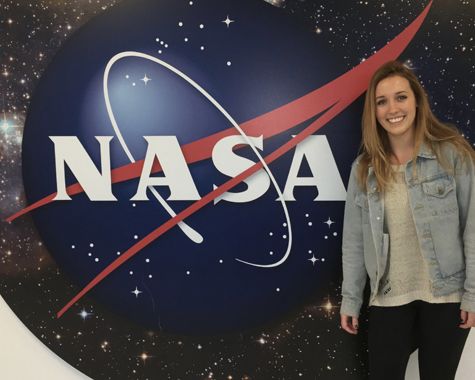
Credit: Danielle Simkus
Did you always know that you wanted to be an astrobiologist?
No, I didn’t. In fact, it wasn’t until my first year of my undergraduate program that I really discovered my passion for space sciences. With my dad being a chemical engineer, my mom an educator, and my sister pursuing a career in epidemiology, my family naturally instilled in me a curiosity for science and education. I was enrolled in a Biological Sciences program, but when I took an astronomy course as an elective, I quickly realized how intrigued I was by space research. I initially considered pursuing a degree in astrophysics, mainly because it was the one “astro”-focused program offered at my university, but I knew that biology was a better fit for my strengths.
While researching career options available in space sciences, I came across a series of NASA Goddard videos that featured the Astrobiology Analytical Laboratory. I remember watching videos of Drs. Daniel Glavin, Jamie Elsila Cook, and Jason Dworkin (who are now my advisors and colleagues) explaining how they study prebiotic organic matter in meteorites. I remember thinking, “this is exactly what I want to do”. The field of astrobiology was exactly what I was looking for.
I reached out to a professor in geology, Dr. Christopher Herd, for advice on how to pursue a career in this field. It just so happened that he, a planetary geologist, had an open position for a summer intern to analyze the prebiotic chemistry of a meteorite, and I jumped on the opportunity. I spent that summer looking for amino acids in the Tagish Lake meteorite, and I ended up enjoying that project even more than I had dreamed. From that moment forward, I was dedicated to pursuing a career in astrobiology, and I owe a lot of credit to my parents for their unconditional support in that pursuit.
Credit: Danielle Simkus
Tell us about the projects you are currently working on.
Most of my research is focused on the chemistry of meteorites. Meteorites are fragments of asteroids or comets or, in some rare cases, fragments of other types of rocky planetary bodies like the Moon or Mars that have naturally survived their entry through our atmosphere and have landed on the Earth’s surface. There are so many different types of meteorites, all with unique and complex histories, and their chemistry is influenced by their experience in space (e.g., exposure to aqueous alteration or thermal metamorphism). I’m trying to figure out what conditions are optimal for forming and preserving prebiotic molecules based on the organic compounds I detect across a range of meteorite types.
In addition to meteorites, I also analyze moon dust! I’m a member of the Apollo Next Generation Sample Analysis (ANGSA) Program, a consortium that studies lunar soil collected and specially curated by the Apollo Program in the 1970s. Some of these samples have been stored frozen since their collection. Some material was sealed on the moon and, therefore, stored essentially under vacuum for 50 years. In the Astrobiology Analytical Lab, we’re looking for amino acids and related prebiotic molecules to see what prebiotic chemistry is present on the moon. We want to learn about how that chemistry varies across different regions of the lunar surface and how the methods of collection and storage affect the samples.
Lastly (but definitely not least!), I am a Science Team Collaborator for NASA’s OSIRIS-REx mission, a sample-return mission to the asteroid Bennu. OSIRIS-REx launched in 2016 and has already completed its sample collection at Bennu. It’s currently on its journey back to Earth and will be returning asteroid material to us in the fall of next year (2023). OSIRIS-REx is really the best opportunity we’ve had yet to learn about the intrinsic prebiotic chemistry of a carbon-rich asteroid. Unlike meteorites (whose exact parent bodies are generally unknown), we’ll have in-depth information about the parent asteroid Bennu that will provide context for the chemistry we’re seeing. We will also have the benefit of a comprehensive team from all different fields of research learning and collaborating together.
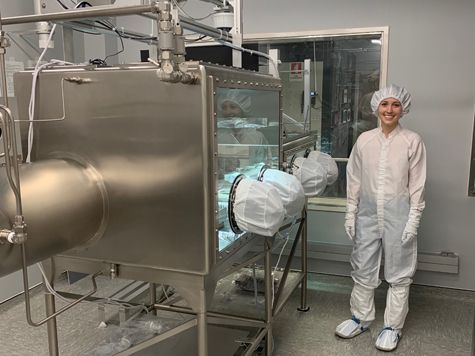
Credit: Danielle Simkus
What aspects of your job are you most passionate about?
One part of my job that I particularly enjoy is science writing. I like taking complex science concepts, parsing them down, and trying to present them in a language and style of writing that is accessible to a broad audience. In fact, this is one of the reasons why I enjoy working on the Early Career Scientist Spotlight series so much! As a co-editor for the series, I’m continuously learning how to become a better science writer while also learning about all of the interesting people and impressive science happening at Goddard.
I like putting together science presentations for the same reasons. It’s a great feeling when someone comes up to you after your talk excitedly telling you that they were able to follow the science the whole way through. It might seem like a bit of a low bar, but presenting complex science is hard, and I do feel proud when others can fully grasp the concepts I’m sharing!
Credit: Danielle Simkus
What science fact consistently amazes you?
The concept of homochirality on Earth is something that I find super interesting! To put it very simply, some amino acids (which we call “chiral” amino acids) can exist in either a “left-handed” form or a “right-handed” form – both have the same chemical formula, but their structures are mirror images of one another. For the most part, life on Earth uses only the left-handed form of chiral amino acids and it’s a mystery as to why the right-handed form isn’t used. This uniformity of handedness is called “homochirality” and we still don’t really know why life originated or evolved this way. There doesn’t appear to be a benefit or incentive for life to evolve using one version or the other. And without a selective driving force in a chemical reaction, we expect the two mirror-image structures (the “left-handed” and “right-handed” forms) of a chiral molecule to be produced in equal abundances. So, why do we see this phenomenon? I hope to someday find out!
Homochirality in biology might be a very important clue as to when and how life originated on Earth. Understanding the origin of life on Earth might be the first step in understanding how life could emerge elsewhere. Measuring chirality is also one of the ways we can tell whether a meteorite sample is contaminated. If we detect a common protein amino acid in a meteorite (e.g., alanine), and it’s mostly or entirely present in its left-handed form (L-alanine), we will suspect our meteorite is contaminated. But if we detect both left-handed and right-handed alanine in equal abundances, we can feel pretty confident that we’re observing an amino acid that formed in space.
As if all of this wasn’t interesting enough, another cool fact is that sometimes we actually find an excess of the left-handed form of amino acids in meteorites, even when we know for a fact that the amino acids we’re looking at are from space and not contaminants. For instance, isovaline, which is a very rare amino acid on Earth but is common in meteorites, is sometimes more abundant in its left-handed form. The intriguing (and controversial) question is whether meteorites could have seeded the Earth with an excess of the left-handed form of amino acids, and then life on Earth just happened to evolve using what it was given.

Credit: Sarah Schade Photography
What keeps you motivated?
(1) Thinking about the vastness of space. Knowing that our little Earth is pretty much insignificant in proportion to the Universe not only inspires me to learn more about space, but it also helps me feel grounded. I know that some of my day-to-day concerns are minuscule compared to the enormity of space and it can be surprisingly calming to reflect on that.
(2) The possibility of extraterrestrial life. Identifying life beyond Earth would be the most amazing discovery imaginable (in my opinion) and I love being a part of a community that shares the same ambition.
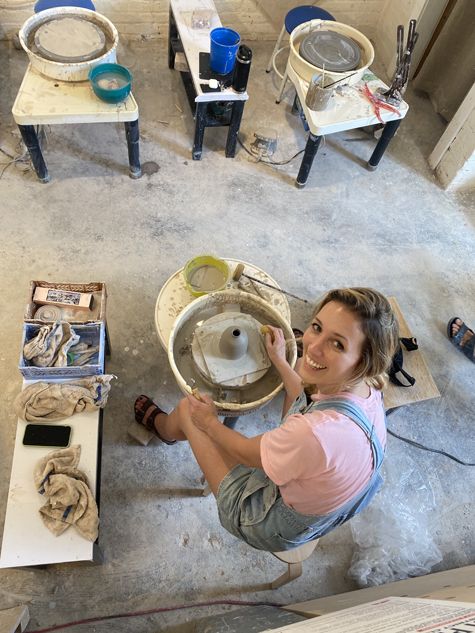
Credit: Noah Hahn
What do you like to do in your free time?
Some of my favourite activities are arts and crafts. I like to draw and paint, and I also sew (I even sewed my bridesmaids’ dresses for my wedding). As of more recently, I’m really into pottery! My husband and I started taking a pottery wheel class last fall, originally thinking we would only take one 10-week course. But we became absolutely hooked and have been signing up for classes again and again. Now we’re at the studio every chance we get! My other favourite pastime is hanging out with my Bernese Mountain Dog, Kevin. We brought Kevin home as an 8-week old pup just about one week before things started shutting down at the start of the pandemic. It couldn’t have been better timing. He is a wonderful working-from-home partner and a happy distraction during tough times. Kevin is over 125 lbs now, a huge goofball, and just the sweetest.
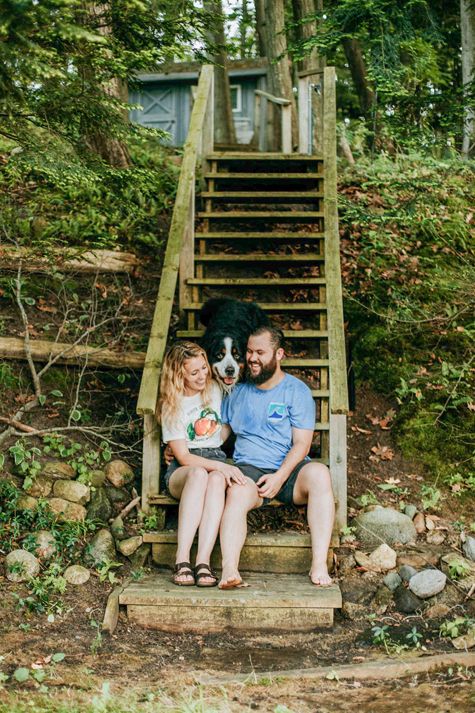
Credit: Sarah Schade Photography
Biography
Home Town:
Kamloops, British Columbia, Canada
Undergraduate Degree:
B.Sc. (Double Major in Biological Sciences and Earth & Atmospheric Sciences), University of Alberta, Edmonton, Canada
Post-graduate Degrees:
M.Sc. in Earth & Environmental Sciences, Collaborative Graduate Program in Astrobiology, McMaster University, Hamilton, Canada
Ph.D. in Earth & Atmospheric Sciences, University of Alberta, Edmonton, Canada
